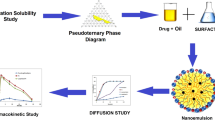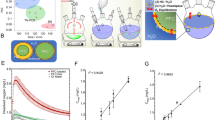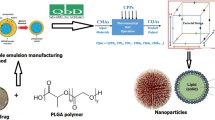Abstract
Pain nanomedicine is an emerging field in response to current needs of addressing the opioid crisis in the USA and around the world. Our group has focused on the development of macrophage-targeted perfluorocarbon nanoemulsions as inflammatory pain nanomedicines over the past several years. We present here, for the first time, a quality by design approach used to design pain nanomedicine. Specifically, we used failure mode, effects, and criticality analysis (FMECA) which identified the process and composition parameters that were most likely to impact nanoemulsion critical quality attributes (CQAs). From here, we applied a unique combination approach that compared multiple linear regression, boosted decision tree regression, and partial least squares regression methods in combination with correlation plots. The presented combination approach allowed for in-depth analyses of which formulation steps in the nanoemulsification processes control nanoemulsion droplet diameter, stability, and drug loading. We identified that increase in solubilizer (transcutol) content increased drug loading and decreased nanoemulsion stability. This was mitigated by inclusion of perfluorocarbon oil in the internal phase. We observed negative correlation (R2 = 0.4357, p value 0.0054) between the amount of PCE and the percent diameter increase (destabilization), and no correlation between processing parameters and percent diameter increase over time. Further, we identified that increased sonication time decreases nanoemulsion drug loading but does not significantly impact droplet diameter or stability. We believe the methods presented here can be useful in the development of various nanomedicines to produce higher-quality products with enhanced manufacturing and design control.



Similar content being viewed by others
References
Ventola CL. Progress in nanomedicine: approved and investigational Nanodrugs. P T. 2017;42(12):742–55.
Fact Sheet - Pain Management. National Institutes of Health; 2010.
Yuangyai C, Nembhard HB. Design of experiments: a key to innovation in nanotechnology. In: Ahmed W, Jackson MJ, editors. Emerging nanotechnologies for manufacturing. 2nd ed. Waltham, MA: William Andrew; 2014. p. 230–54.
Li J, Qiao Y, Wu Z. Nanosystem trends in drug delivery using quality-by-design concept. J Control Release. 2017;256:9–18.
Shah B, Khunt D, Bhatt H, Misra M, Padh H. Intranasal delivery of venlafaxine loaded nanostructured lipid carrier: risk assessment and QbD based optimization. J Drug Deliv Sci Technol. 2016;33:37–50.
Srinivas NSK, Verma R, Kulyadi GP, Kumar L. A quality by design approach on polymeric nanocarrier delivery of gefitinib: formulation, in vitro, and in vivo characterization. Int J Nanomedicine. 2017;12:15–28.
Hormann K, Zimmer A. Drug delivery and drug targeting with parenteral lipid nanoemulsions - a review. J Control Release. 2016;223:85–98.
Gupta A, Eral HB, Hatton TA, Doyle PS. Nanoemulsions: formation, properties and applications. Soft Matter. 2016;12(11):2826–41.
Chavez-Zamudio R, Ochoa-Flores AA, Soto-Rodriguez I, Garcia-Varela R, Garcia HS. Preparation, characterization and bioavailability by oral administration of O/W curcumin nanoemulsions stabilized with lysophosphatidylcholine. Food Funct. 2017;8(9):3346–54.
Isailovic T, Ethordevic S, Markovic B, Randelovic D, Cekic N, Lukic M, et al. Biocompatible nanoemulsions for improved aceclofenac skin delivery: formulation approach using combined mixture-process experimental design. J Pharm Sci. 2016;105(1):308–23.
Kwasigroch B, Escribano E, Moran MDC, Queralt J, Busquets MA, Estelrich J. Oil-in-water nanoemulsions are suitable for carrying hydrophobic compounds: indomethacin as a model of anti-inflammatory drug. Int J Pharm. 2016;515(1–2):749–56.
Pain relief: taking NSAIDs safely. Before you use these popular pain pills, weigh the heart risks and other side effects carefully. Harv Womens Health Watch. 2013;21(1):3.
Filaretova LP, Bagaeva TR, Morozova OY, Zelena D. The healing of NSAID-induced gastric lesion may be followed by small intestinal and cardiovascular side effects. J Physiol Pharmacol. 2011;62(6):619–25.
Maniar KH, Jones IA, Gopalakrishna R, Vangsness CT Jr. Lowering side effects of NSAID usage in osteoarthritis: recent attempts at minimizing dosage. Expert Opin Pharmacother. 2018;19(2):93–102.
Mantry P, Shah A, Sundaram U. Celecoxib associated esophagitis: review of gastrointestinal side effects from cox-2 inhibitors. J Clin Gastroenterol. 2003;37(1):61–3.
Stollberger C, Finsterer J. Side effects of conventional nonsteroidal anti-inflammatory drugs and celecoxib: more similarities than differences. South Med J. 2004;97(2):209.
Gong L, Thorn CF, Bertagnolli MM, Grosser T, Altman RB, Klein TE. Celecoxib pathways: pharmacokinetics and pharmacodynamics. Pharmacogenet Genomics. 2012;22(4):310–8.
Payne R. Limitations of NSAIDs for pain management: toxicity or lack of efficacy? J Pain. 2000;1(3):14–8.
Baboota S, Shakeel F, Ahuja A, Ali J, Shafiq S. Design, development and evaluation of novel nanoemulsion formulations for transdermal potential of celecoxib. Acta Pharma. 2007;57(3):315–32.
Shakeel F, Baboota S, Ahuja A, Ali J, Shafiq S. Enhanced anti-inflammatory effects of celecoxib from a transdermally applied nanoemulsion. Pharmazie. 2009;64(4):258–9.
Janjic JM, Vasudeva K, Saleem M, Stevens A, Liu L, Patel S, et al. Low-dose NSAIDs reduce pain via macrophage targeted nanoemulsion delivery to neuroinflammation of the sciatic nerve in rat. In: J Neuroimmunol, vol. 318; 2018. p. 72–9.
Patel SK, Beaino W, Anderson CJ, Janjic JM. Theranostic nanoemulsions for macrophage COX-2 inhibition in a murine inflammation model. Clin Immunol. 2015;160(1):59–70.
Vasudeva K, Andersen K, Zeyzus-Johns B, Hitchens TK, Patel SK, Balducci A, et al. Imaging neuroinflammation in vivo in a neuropathic pain rat model with near-infrared fluorescence and (1)(9)F magnetic resonance. PLoS One. 2014;9(2):e90589.
Ganta S, Singh A, Kulkarni P, Keeler AW, Piroyan A, Sawant RR, et al. EGFR targeted theranostic nanoemulsion for image-guided ovarian cancer therapy. Pharm Res. 2015;32(8):2753–63.
Gianella A, Jarzyna PA, Mani V, Ramachandran S, Calcagno C, Tang J, et al. Multifunctional nanoemulsion platform for imaging guided therapy evaluated in experimental cancer. ACS Nano. 2011;5(6):4422–33.
Fernandez-Fernandez A, Manchanda R, McGoron AJ. Theranostic applications of nanomaterials in cancer: drug delivery, image-guided therapy, and multifunctional platforms. Appl Biochem Biotechnol. 2011;165(7–8):1628–51.
Liu L, Bagia C, Janjic JM. The first scale-up production of theranostic nanoemulsions. BioResearch Open Access. 2015;4:218–28.
Janjic JM, Berlec A, Bagia C, Liu L, Jeric I, Gach M, et al. NIR and MRI imaging supported hydrogel based delivery system for anti TNF alpha probiotic therapy of IBD. SPIE proceeding. 2016;8:10.
Michele Herneisey JW, Mirtic J, Liu L, Potdar S, Bagia C, Cavanaugh J, et al. Development and characterization of resveratrol nanoemulsions carrying dual- imaging agents. Ther Deliv. 2016.
Patel SK, Janjic JM. Macrophage targeted theranostics as personalized nanomedicine strategies for inflammatory diseases. Theranostics. 2015;5(2):150–72.
Patel SK, Zhang Y, Pollock JA, Janjic JM. Cyclooxgenase-2 inhibiting perfluoropoly (ethylene glycol) ether theranostic nanoemulsions-in vitro study. PLoS One. 2013;8(2):e55802.
Seok SH, Lee S-A, Park E-S. Formulation of a microemulsion-based hydrogel containing celecoxib. J Drug Deliv Sci Technol. 2018;43:409–14.
Shah SM, Jain AS, Kaushik R, Nagarsenker MS, Nerurkar MJ. Preclinical formulations: insight, strategies, and practical considerations. AAPS PharmSciTech. 2014;15(5):1307–23.
U.S. Pharmacopoeia [USP 34 Microgiological Tests / <71> Sterility Tests]. Rockville, MD2011. p. 65–70.
Acknowledgements
The views expressed are those of the authors and do not reflect the official view or policy of the Department of Defense, Department of the Army, Department of the Air Force or its Components.
Funding
The presented work was supported by the following awards: AFMSA Department of Defense Award FA8650-17-2-6836, National Institute of Biomedical Engineering and Imaging Award R21EB023104-02 and National Institute on Drug Abuse Award R21 DA039621-02.
Author information
Authors and Affiliations
Corresponding author
Additional information
Publisher’s Note
Springer Nature remains neutral with regard to jurisdictional claims in published maps and institutional affiliations.
Electronic Supplementary Material
ESM 1
(DOCX 26936 kb)
Rights and permissions
About this article
Cite this article
Herneisey, M., Liu, L., Lambert, E. et al. Development of Theranostic Perfluorocarbon Nanoemulsions as a Model Non-Opioid Pain Nanomedicine Using a Quality by Design (QbD) Approach. AAPS PharmSciTech 20, 65 (2019). https://doi.org/10.1208/s12249-018-1287-6
Received:
Accepted:
Published:
DOI: https://doi.org/10.1208/s12249-018-1287-6




